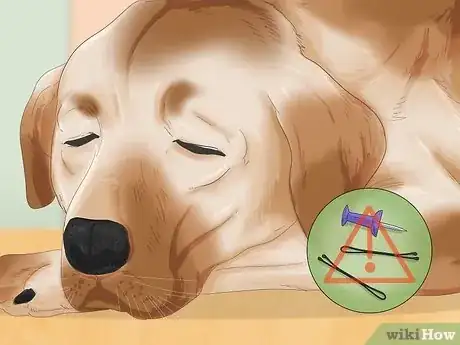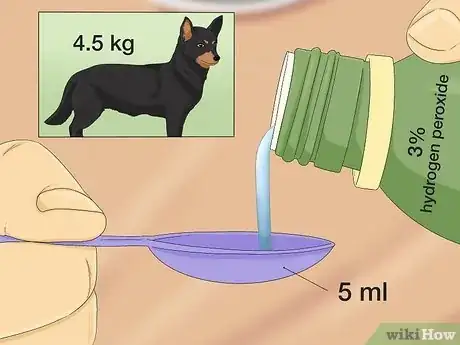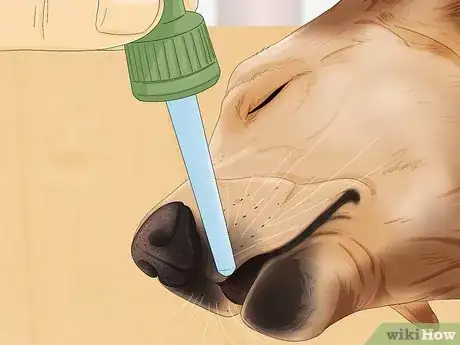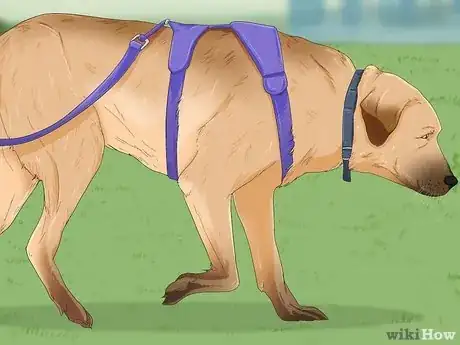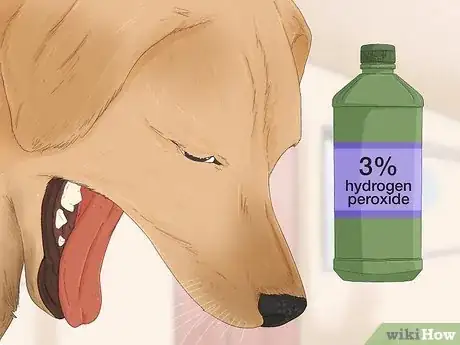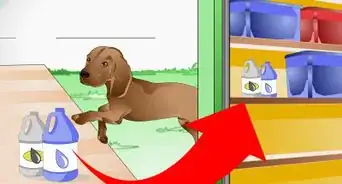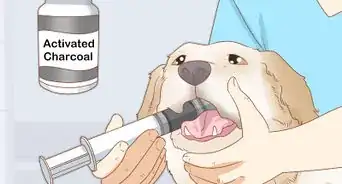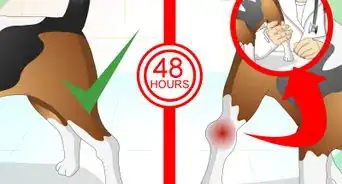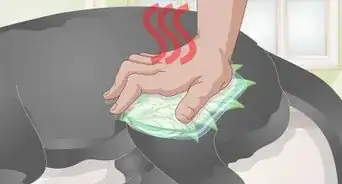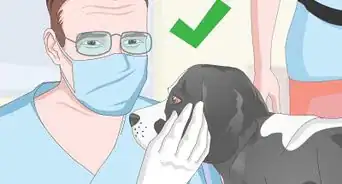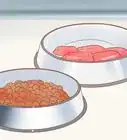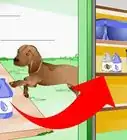This article was co-authored by Ray Spragley, DVM and by wikiHow staff writer, Amber Crain. Dr. Ray Spragley is a Doctor of Veterinary Medicine and the Owner/Founder of Zen Dog Veterinary Care PLLC in New York. With experience in multiple institutions and private practices, Dr. Spragley’s specializations and interests include non-surgical management of cranial cruciate ligament tears, Intervertebral Disk Disease(IVDD), and pain management in osteoarthritis. Dr. Spragley holds a BS in Biology from SUNY Albany and has a Doctor of Veterinary Medicine degree (DVM) from Ross University School of Veterinary Medicine. He is also a Certified Canine Rehabilitation Therapist (CCRT) through the Canine Rehab Institute as well as a Certified Veterinary Acupuncturist (CVA) through Chi University.
wikiHow marks an article as reader-approved once it receives enough positive feedback. In this case, 100% of readers who voted found the article helpful, earning it our reader-approved status.
This article has been viewed 911,574 times.
If you think your dog has ingested something harmful, like a toxin or foreign object, making it vomit can prevent serious illness and even death. This may sound like your go-to solution, but there are situations when it isn’t safe for your dog. In this article, we'll explain when it’s okay to make your dog throw up at home and walk you through how to do it properly. We’ll also discuss when to avoid making a dog vomit (and what you should do instead). Take a deep breath—we're here to help.
Things You Should Know
- Induce vomiting within 2 hours if your dog swallowed antifreeze, chocolate, or grapes. Never make a dog throw up after ingesting a sharp object.
- Measure out 1 tsp (5 ml) of 3% hydrogen peroxide for every 10 lbs (4.5 kg) of your dog's body weight.
- Use a dropper to put the peroxide on the back of your dog’s tongue. You can also soak a cotton ball in peroxide and squeeze it into your dog's mouth.
Steps
How to Make a Dog Vomit at Home
-
1Feed the dog a small meal if it hasn’t eaten in the last 2 hours. This may sound counterintuitive, but feeding your dog a little food actually increases the chances of vomiting and makes the vomit a little easier for your dog to pass. A small portion of canned food or a slice of toast will do the trick.[9]
- If your dog refuses to eat, don’t waste time trying to force it.
- Move your dog to a quiet area that will allow for easy cleanup.
-
2Measure out 1 tsp (5 ml) of 3% hydrogen peroxide per 10 lbs (4.5 kg) of your dog's body weight. If your vet or poison control center says it’s okay to induce vomiting, you can safely give your dog 3% hydrogen peroxide to make it throw up. Use a measuring spoon to measure the right amount.
- Measure carefully. Giving your dog too much peroxide can cause additional health problems.[10]
-
3Use a dropper to put the hydrogen peroxide in your dog's mouth. Draw up the hydrogen peroxide into an ear or eye dropper or a syringe. Drop the measured amount of hydrogen peroxide as far back on your dog’s tongue as you can.[11]
- If you don't have a dropper or syringe, check your kitchen for a baster. Failing that, soak a cotton ball in peroxide and squeeze it into your dog's mouth.
-
4Encourage your dog to walk around. Moving around will make the contents of your dog’s stomach mix with the hydrogen peroxide. Walk your dog for a few minutes to jumpstart the process. If your dog isn’t up to walking, gently shake or move its belly.[12]
-
5Wait 10-15 minutes for your dog to vomit. Vomiting usually begins quickly after a dog ingests hydrogen peroxide—usually within 10 minutes. If your dog does not vomit after 10-15 minutes, give it a second dose of hydrogen peroxide.[13]
- If your dog hasn’t thrown up after 2 doses of hydrogen peroxide, do not administer any more. Seek emergency assistance.
Expert Q&A
-
QuestionShould I be concerned if my dog threw up out of nowhere?
 Ray Spragley, DVMDr. Ray Spragley is a Doctor of Veterinary Medicine and the Owner/Founder of Zen Dog Veterinary Care PLLC in New York. With experience in multiple institutions and private practices, Dr. Spragley’s specializations and interests include non-surgical management of cranial cruciate ligament tears, Intervertebral Disk Disease(IVDD), and pain management in osteoarthritis. Dr. Spragley holds a BS in Biology from SUNY Albany and has a Doctor of Veterinary Medicine degree (DVM) from Ross University School of Veterinary Medicine. He is also a Certified Canine Rehabilitation Therapist (CCRT) through the Canine Rehab Institute as well as a Certified Veterinary Acupuncturist (CVA) through Chi University.
Ray Spragley, DVMDr. Ray Spragley is a Doctor of Veterinary Medicine and the Owner/Founder of Zen Dog Veterinary Care PLLC in New York. With experience in multiple institutions and private practices, Dr. Spragley’s specializations and interests include non-surgical management of cranial cruciate ligament tears, Intervertebral Disk Disease(IVDD), and pain management in osteoarthritis. Dr. Spragley holds a BS in Biology from SUNY Albany and has a Doctor of Veterinary Medicine degree (DVM) from Ross University School of Veterinary Medicine. He is also a Certified Canine Rehabilitation Therapist (CCRT) through the Canine Rehab Institute as well as a Certified Veterinary Acupuncturist (CVA) through Chi University.
Veterinarian No, dogs throw up on occasion. If they aren't acting strange or sick and they haven't eaten anything potentially dangerous, you probably shouldn't worry about it too much.
No, dogs throw up on occasion. If they aren't acting strange or sick and they haven't eaten anything potentially dangerous, you probably shouldn't worry about it too much. -
QuestionWhat should I do if I'm not sure what my dog ate was dangerous?
 Ray Spragley, DVMDr. Ray Spragley is a Doctor of Veterinary Medicine and the Owner/Founder of Zen Dog Veterinary Care PLLC in New York. With experience in multiple institutions and private practices, Dr. Spragley’s specializations and interests include non-surgical management of cranial cruciate ligament tears, Intervertebral Disk Disease(IVDD), and pain management in osteoarthritis. Dr. Spragley holds a BS in Biology from SUNY Albany and has a Doctor of Veterinary Medicine degree (DVM) from Ross University School of Veterinary Medicine. He is also a Certified Canine Rehabilitation Therapist (CCRT) through the Canine Rehab Institute as well as a Certified Veterinary Acupuncturist (CVA) through Chi University.
Ray Spragley, DVMDr. Ray Spragley is a Doctor of Veterinary Medicine and the Owner/Founder of Zen Dog Veterinary Care PLLC in New York. With experience in multiple institutions and private practices, Dr. Spragley’s specializations and interests include non-surgical management of cranial cruciate ligament tears, Intervertebral Disk Disease(IVDD), and pain management in osteoarthritis. Dr. Spragley holds a BS in Biology from SUNY Albany and has a Doctor of Veterinary Medicine degree (DVM) from Ross University School of Veterinary Medicine. He is also a Certified Canine Rehabilitation Therapist (CCRT) through the Canine Rehab Institute as well as a Certified Veterinary Acupuncturist (CVA) through Chi University.
Veterinarian Grab the packaging or look up the contents of whatever they ate online and call your vet. Ask them if what they've eaten is dangerous. If your vet isn't around or they aren't sure, call ASPCA's animal control.
Grab the packaging or look up the contents of whatever they ate online and call your vet. Ask them if what they've eaten is dangerous. If your vet isn't around or they aren't sure, call ASPCA's animal control. -
QuestionCan I give my dog hydrogen peroxide at home?
 Ray Spragley, DVMDr. Ray Spragley is a Doctor of Veterinary Medicine and the Owner/Founder of Zen Dog Veterinary Care PLLC in New York. With experience in multiple institutions and private practices, Dr. Spragley’s specializations and interests include non-surgical management of cranial cruciate ligament tears, Intervertebral Disk Disease(IVDD), and pain management in osteoarthritis. Dr. Spragley holds a BS in Biology from SUNY Albany and has a Doctor of Veterinary Medicine degree (DVM) from Ross University School of Veterinary Medicine. He is also a Certified Canine Rehabilitation Therapist (CCRT) through the Canine Rehab Institute as well as a Certified Veterinary Acupuncturist (CVA) through Chi University.
Ray Spragley, DVMDr. Ray Spragley is a Doctor of Veterinary Medicine and the Owner/Founder of Zen Dog Veterinary Care PLLC in New York. With experience in multiple institutions and private practices, Dr. Spragley’s specializations and interests include non-surgical management of cranial cruciate ligament tears, Intervertebral Disk Disease(IVDD), and pain management in osteoarthritis. Dr. Spragley holds a BS in Biology from SUNY Albany and has a Doctor of Veterinary Medicine degree (DVM) from Ross University School of Veterinary Medicine. He is also a Certified Canine Rehabilitation Therapist (CCRT) through the Canine Rehab Institute as well as a Certified Veterinary Acupuncturist (CVA) through Chi University.
Veterinarian You theoretically could, but I wouldn't recommend it. It's much safer to have a vet do this so that they can administer a safe amount and see how your dog responds.
You theoretically could, but I wouldn't recommend it. It's much safer to have a vet do this so that they can administer a safe amount and see how your dog responds.
Warnings
- Sharp objects can damage the lining of the stomach or esophagus. If you know your dog swallowed a sharp object, do not get your dog to vomit.⧼thumbs_response⧽
References
- ↑ https://www.stlouisanimalemergencyclinic.org/site/blog/2022/02/08/dogs-vomiting
- ↑ Ray Spragley, DVM. Veterinarian. Expert Interview. 19 February 2021.
- ↑ https://www.aspca.org/news/it-ever-safe-induce-vomiting
- ↑ https://www.aspcapro.org/resource/when-not-use-emetics-dogs-and-cats
- ↑ https://www.aspca.org/news/it-ever-safe-induce-vomiting
- ↑ https://www.vetinfo.com/emergency-procedures-to-induce-vomiting-in-dogs.html
- ↑ https://www.stlouisanimalemergencyclinic.org/site/blog/2022/02/08/dogs-vomiting
- ↑ https://www.aspca.org/news/it-ever-safe-induce-vomiting
- ↑ https://www.vetinfo.com/emergency-procedures-to-induce-vomiting-in-dogs.html
- ↑ https://www.aspca.org/news/it-ever-safe-induce-vomiting
- ↑ https://www.vetinfo.com/emergency-procedures-to-induce-vomiting-in-dogs.html
- ↑ https://www.vetinfo.com/emergency-procedures-to-induce-vomiting-in-dogs.html
- ↑ https://www.vetinfo.com/emergency-procedures-to-induce-vomiting-in-dogs.html
- ↑ https://www.stlouisanimalemergencyclinic.org/site/blog/2022/02/08/dogs-vomiting
- ↑ https://www.aspca.org/news/it-ever-safe-induce-vomiting
About This Article
If your dog has swallowed antifreeze, chocolate, grapes, medication, or a poisonous plant and you need to induce vomiting, start by getting your dog to eat something small, like some canned food or a piece of bread, which will make vomiting easier. If your dog won't eat, skip this step and move on. Next, use an ear or eye dropper to feed your dog 1 tablespoon of 3 percent hydrogen peroxide for every 10 pounds your dog weighs. After you administer the hydrogen peroxide, take your dog for a walk or gently shake its stomach so it vomits. To learn how to tell if you should take your dog to the vet instead of inducing vomiting, scroll down.



